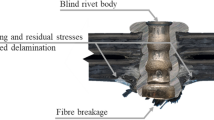Abstract
Fiber reinforced polymers (FRPs) are accepted as an efficient material for external strengthening of masonry structures. Previous researches have shown that the bond between FRP and the substrate plays an important role in the effectiveness of this strengthening technique. Extensive investigations have been devoted to the characterization of the short-term bond behavior, while its durability and long-term performance requires further studies. In this regard, a full experimental program for investigating the environmental durability of bond in FRP-strengthened masonry is crucial for understanding the degrading mechanisms. This paper presents the results of an experimental program aimed at investigating the hygrothermal durability of bond in FRP-strengthened bricks. Accelerated ageing tests were performed on the FRP-strengthened brick elements and the bond degradation was periodically investigated by visual inspection and by conventional single-lap shear bond tests. The changes in the properties of material constituents have also been monitored. The obtained results are presented and critically discussed.














Similar content being viewed by others
References
ASTM D7565-10 (2010) Standard test method for determining tensile properties of fiber reinforced polymer matrix composites used for strengthening of civil structures, vol ASTM D7565. doi:10.1520/D7565_D7565M-10
Capozucca R (2012) Effects of mortar layers in the delamination of GFRP bonded to historic masonry. Compos B 44(1):639–649
Carol L, Schutte CL (1994) Environmental durability of glass-fiber composites. Mater Sci Eng A 13(7):265–323
CNR-DT 200 (2004) Guide for the design and construction of externally bonded FRP systems for strengthening existing structures. CNR-DT 200/2004. National Research Council, Rome
Colombi P, Fava G, Poggi C (2010) Bond strength of CFRP–concrete elements under freeze–thaw cycles. Compos Struct 92(4):973–983
Cromwell JR, Harries KA, Shahrooz BM (2011) Environmental durability of externally bonded FRP materials intended for repair of concrete structures. Constr Build Mater 25(5):2525–2539
Davalos JF, Kodkani SS, Ray I, Lin C (2008) Fracture evaluation of GFRP–concrete interfaces for freeze–thaw and wet–dry cycling. J Compos Mater 42(14):1439–1466
Dohnalek P (2006) Environmental durability of FRP bond to concrete subjected to freeze–thaw action. MSc Thesis, MIT
Dutta PK, Hui D (1996) Low-temperature and freeze–thaw durability of thick composites. Compos B 27(3–4):371–379
EN 772-1 (2002) Methods of test for masonry units—part 1: determination of compressive strength
Faella C, Camorani G, Martinelli E, Paciello S, Perri F (2012) Bond behavior of FRP strip glued on masonry: experimental investigation and empirical formulation. Constr Build Mater 31:353–363
Frigione M, Aiello MA, Naddeo C (2006) Water effects on the bond strength of concrete/concrete adhesive joints. Constr Build Mater 20(10):957–970
Frigione M, Lettieri M, Mecchi AM (2006) Environmental effects on epoxy adhesives employed for restoration of historical buildings. J Mater Civil Eng 18(5):715–722
Ghiassi B, Marcari G, Oliveira DV, Lourenço PB (2012) Numerical analysis of bond behavior between masonry bricks and composite materials. Eng Struct 43:210–220
Ghiassi B, Oliveira DV, Lourenço PB, Marcari A (2012) Numerical study of the role of mortar joints in the bond behavior of FRP-strengthened masonry. Compos B 46:21–30
Ghiassi B, Marcari G, Oliveira DV, Lourenço PB (2013) Water degrading effects on the bond behavior in FRP-strengthened masonry. Compos B 54:11–19
Ghiassi B, Silva SM, Oliveira DV, Lourenço PB, Bragança L (2014) Assessment of the bond quality degradation in FRP-strengthened masonry using IR thermography technique. J Nondestruct Eval. doi:10.1007/s10921-014-0238-8
Grande E, Imbimbo M, Sacco E (2008) Experimental investigation on the bond behavior of CFRP laminates glued on clay bricks. In: CICE2008, Zurich
Green MF, Bibsy LA, Beaudoin Y, Labossière P (2000) Effect of freeze–thaw cycles on the bond durability between fiber reinforced polymer plate reinforcement and concrete. Can J Civil Eng 27(5):949–959
Haldar A, Mahadevan S (2000) Probability, reliability and statistical methods in engineering design. Wiley, New York
Hollaway LC (2010) A review of the present and future utilisation of FRP composites in the civil infrastructure with reference to their important in-service properties. Constr Build Mater 24(12):2419–2445
ISO 527-1 (2012) Plastics-determination of tensile properties—part 1: general principles
Karbhari VM (2002) Reponse of fiber reinforced polymer confined concrete exposed to freeze and freeze–thaw regimes. J Compos Constr 6(1):35–40
Karbhari VM (2007) Durability of composites for civil structural applications. CRC Press, Washington, DC
Karbhari VM, Chin W, Hunston D, Benmokrane B, Juska T, Morgan R, Lesko JJ, Sorathia U, Reynaud D (2003) Durability gap analysis for fiber-reinforced polymer composites in civil infrastructures. J Compos Constr 7(3):238–247
Khoshbakht M, Lin MW (2010) A finite element model for hygro-thermo-mechanical analysis of masonry walls with FRP reinforcement. Finite Elem Anal Des 46(10):783–791
Kralj B, Pande GN, Middleton J (1991) On the mechanics of frost damage to brick masonry. Compos Struct 41(1):53–66
Lau D, Buyukozturk O (2010) Fracture characterization of concrete/epoxy interface affected by moisture. Mech Mater 42(12):1031–1042
Moy P, Karasz F (1980) Epoxy-water interactions. Polym Eng Sci 20(4):315–319
Ouyang Z, Wan B (2008) Experimental and numerical study of water effect on bond fracture energy between FRP and concrete in moist environments. J Reinf Plast Compos 27(2):205–223
Sciolti MS, Aiello MA, Frigione M (2012) Influence of water on bond behavior between CFRP sheet and natural calcareous stones. Compos B 43(8):3239–3250
UNI EN 8942-3 (1986) Clay bricks and blocks. Test methods
Valluzzi MR, Oliveira DV, Caratelli A et al (2012) Round robin test for composite-to-brick shear bond characterization. J Mater Struct 45(12):1761–1791
Wan B, Petrou MF, Harries KA (2006) Effect of the presence of water on the durability of bond between CFRP and concrete. J Reinf Plast Compos 25(8):875–890
Acknowledgments
This work was developed within the framework of the RILEM Technical Committee “223-MSC: Masonry Strengthening with Composite Materials”. The financial support from the project FP7-ENV-2009-1-244123-NIKER of the 7th Framework Program of the European Commission is gratefully acknowledged. The first author also acknowledges the financial support of the Portuguese Science Foundation (Fundação de Ciência e Tecnologia, FCT), through grant SFRH/BD/80697/2011.
Author information
Authors and Affiliations
Corresponding author
Rights and permissions
About this article
Cite this article
Ghiassi, B., Oliveira, D.V. & Lourenço, P.B. Hygrothermal durability of bond in FRP-strengthened masonry. Mater Struct 47, 2039–2050 (2014). https://doi.org/10.1617/s11527-014-0375-7
Received:
Accepted:
Published:
Issue Date:
DOI: https://doi.org/10.1617/s11527-014-0375-7




